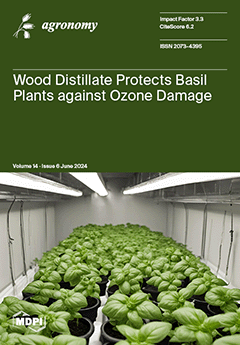Soil texture affects rice nutrient uptake and yield formation by influencing soil structure, microbial activity, and soil nutrient supply capacity. Analyzing the relationship between soil texture, nutrient content, and rice agronomic traits is of great significance for precise and efficient fertilizer application. The
[...] Read more.
Soil texture affects rice nutrient uptake and yield formation by influencing soil structure, microbial activity, and soil nutrient supply capacity. Analyzing the relationship between soil texture, nutrient content, and rice agronomic traits is of great significance for precise and efficient fertilizer application. The tillage layer (0–20 cm) of 31 paddy fields in China’s main rice-producing areas was collected to perform rice pot experiments, and soil texture characteristics, physicochemical properties, microbial-related indicators, and rice agronomic traits were measured and analyzed. The results showed that these soils could be classified into four types of soil texture: loamy sandy soil, sandy loam soil, silty loam soil, and silty soil. Analysis of variance showed that the available nitrogen (AN), available potassium (AK), and available phosphorus (AP) contents were the highest in silty loam, silty, and sandy loam soils, respectively, and silt loamy soil had the highest CEC. Principal component analysis (PCA) also showed that soil physicochemical properties can be distinguished to a certain extent according to soil texture types. For the relationship of soil texture parameters and soil physicochemical properties, soil organic matter (OM), total nitrogen (TN), AN, ammonium nitrogen (NH
4+-N), and microbial carbon (MBC) contents were positively correlated with soil clay content, AK was positively correlated with silt content, and soil phosphorus status was significantly related to pH. Mantel’s test revealed significant correlations between rice N, P, and K nutrient status, dry matter accumulation, and yield, and soil available nutrient content, MBC, pH, and soil texture parameters. Structural equation modeling (SEM) indicated that sand affected soil available nutrients by regulating pH, while clay can positively influence soil available nutrients by affecting soil organic matter mineralization and microbial activity, thus influencing nutrient absorption and yield formation in rice. Overall, in rice production, the silty and silty loam paddy soil with fine texture and higher clay content facilitates the mineralization of soil organic matter and the activity of soil microbes, resulting in more available soil nutrients, which benefits the rice absorption and accumulation of nutrients. Furthermore, a higher content of clay also promotes the distribution of dry matter to the panicle, thereby promoting rice yield formation.
Full article





